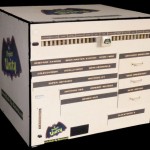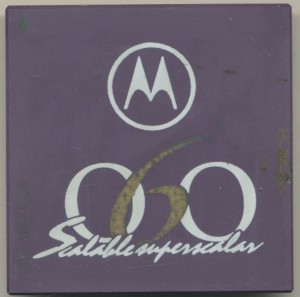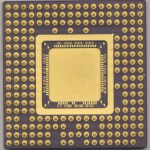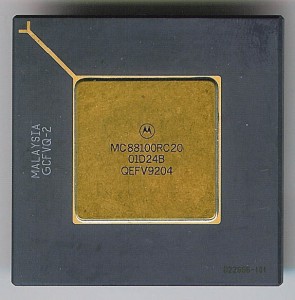April 16th, 2013 ~ by admin
 Master Modder Bacteria recently completed ‘Unity’ a single cabinet integrating 15 classic consoles, and capable of playing games from 18 different systems (sme consoles can run more then one type of game. It an impressive feat especially considering he managed to make it work off a single controller, and a single video/audio output. A custom 15-position switch tops off the console.
Master Modder Bacteria recently completed ‘Unity’ a single cabinet integrating 15 classic consoles, and capable of playing games from 18 different systems (sme consoles can run more then one type of game. It an impressive feat especially considering he managed to make it work off a single controller, and a single video/audio output. A custom 15-position switch tops off the console.
The consoles range from a Intellivision and its oddball CP1610 General Instruments (based on the PDP-11) processor, to the wildly successful 299MHz Sony PS2. Below you can see the variety of systems, and the processors (this IS the CPU Shack after all) that run them.
As you can see a few processors are common. Five of the consoles run Zilog Z-80 processors, and 4 run on some variation of the MOS 6502 made famous by the Apple 1 computer. Later consoles shifted towards the RISC based designs of MIPS, PowerPC and the SuperH series by Hitachi (now Renesas). Today’s console continue to use RISC processors albeit at speeds of over 3GHz.
April 7th, 2013 ~ by admin

Motorola 68060 Marketing Sample
The Motorola 68060 was the last of the 68k line that was begun in the late 1970’s. The 68k began as the first commercial success of a 32 bit processor. It wen through many upgrades, essentially proving to be worth competition (and likely a better architecture) to Intel’s x86 line. The ‘060 was the first 68k to bring a superscalar architecture. It could issue multiple instructions per clock, in some ways it was better then the Intel Pentium. The 68060 was released in 1994 but never achieved wide success. By the time of its introduction Motorola had thrown most of its weight behind the PowerPC of the AIM Alliance. Eventually the 68060, which was released on a 0.6micron process at 50MHz, would be moved to 0.42 micron and hit 75MHz.

It, unfortunately, suffered the same fate as the 88000 RISC processor, a slow but inevitable fading away. The 68k line (mostly the 68000 core, or its derivative, the CPU32) lives on in many of Freescale’s products.
The chip shown is what is known as a Marketing Sample. These typically were only an empty package, given to sale people and distributors as gifts or sales aids. They typically feature a flashy logo, more color, and often, like this one, a sales pitch. ‘Scalable Superscalar’. It seems that the 68060 proved less salable then it was scalable.
April 2nd, 2013 ~ by admin

MC88100 20MHz – 1992
In the late 1980’s Motorola was developing a full 32-bit RISC processor from the ground up. Initially called the 78000, it was renamed the 88000. The first implementation of the 88000 Instruction Set Architecture was the 88100. It included a FPU and integer unit but required a separate chip (the 88200 CMMU) for caching and memory management. Typically 2 of the 88200s were required (one for instruction cache, one for data, 16kb of cache each). A 64lb cache was also available called the 88204. Made on a 1.5u process the 88100 contained 165,000 transistors while the CMMU chips contained 750,000. Each chip dissipated 1.5Watts at 25MHz. Prices in 1989 were $494 for the CPU and $619 each for the CMMUs. A complete system of 3 chips would be nearly $2000. Not exactly competitive pricing.
The initial, and biggest, customers for the 88000 were to be Apple, and Ford Motor Company, an unusual combination to say the least. Apple invested in the 88000 to be the replacement for the 680×0 processors it had been using. Ford was looking to replace the Intel 8061 processors (from which the MCS-96 MCUs were developed) that had run their EEC-IV engine computers since the early 1980’s. Motorola (as well as Toshiba) had been second sourcing these for Ford for sometime. Ford based its choice on the 88100 based ECU on the assumption that Apples adoption of the 88100 would guarantee good software and compiler support. If Apple stuck with it that is..
Read More »
 Master Modder Bacteria recently completed ‘Unity’ a single cabinet integrating 15 classic consoles, and capable of playing games from 18 different systems (sme consoles can run more then one type of game. It an impressive feat especially considering he managed to make it work off a single controller, and a single video/audio output. A custom 15-position switch tops off the console.
Master Modder Bacteria recently completed ‘Unity’ a single cabinet integrating 15 classic consoles, and capable of playing games from 18 different systems (sme consoles can run more then one type of game. It an impressive feat especially considering he managed to make it work off a single controller, and a single video/audio output. A custom 15-position switch tops off the console.



